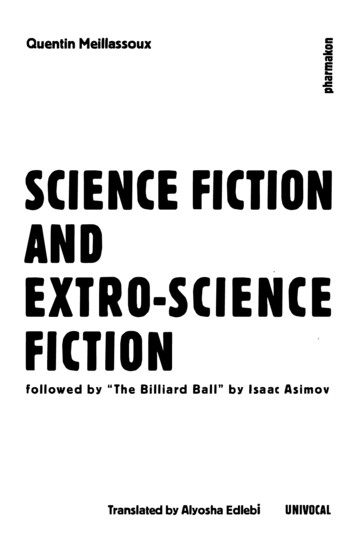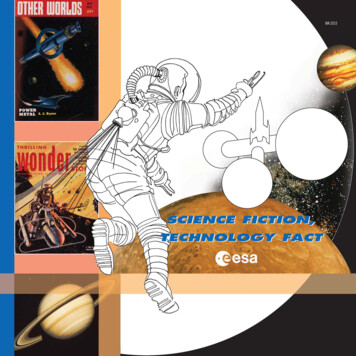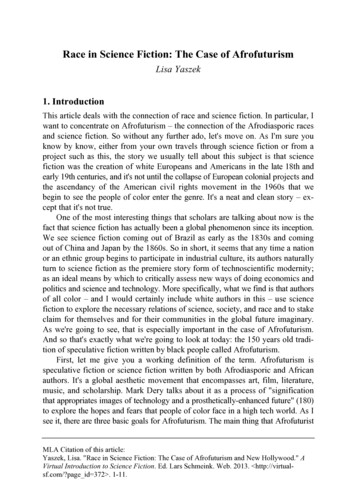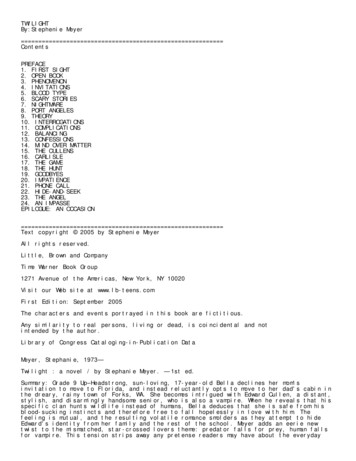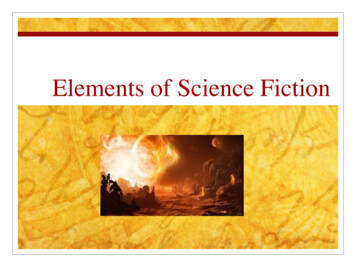
Transcription
Elements of Science Fiction
#1: Science Fiction Reflects Cold War RealitiesYou can’t be a student of American literature and Americanhistory and NOT study science fiction!! History is the ENGINEthat drives literature! Many writers of science fiction draw on thescientific and social trends of the present to describe futuresocieties that might arise if those trends continued. Nuclearproliferation, the space race, early computer technology, andthe pervasive fear of the unknown dangers during the Cold Warwere the realities that prompted a boom in science fiction duringthe 1950s. Cold War politics contributed to the suspicion andparanoia of anything “un-American.” Many Cold War shortstories, novels and films had extraterrestrial invaders and aliensthat were a scantily-veiled substitute for the Communist threat.
#2: Elements ofScience Fiction Realistic and fantastic details Grounded in real SCIENCE! Usually set in the future Unknown inventions/advanced & amazing technology Makes a serious comment about the world Often contains a warning for humankind—sometimescausing mass hysteria
#3: Elements of Science Fiction Can be set in alternate location—another planet,another dimension, new worlds! May contain ALIENS or strange INVADERS andunexplained events Must have a protagonist(hero) and an antagonist(villain) who do battle. The villain was always symbolicof Communism in the 1950s. Will have a problem that must be overcome by the hero
#4: Ray Bradbury onScience Fiction There still are people who will come up to you and say:"Science Fiction? Ha! Why read that?!" The most direct,off-putting reply is: Science fiction is the most importantfiction ever invented by writers. It saw a whole mob oftroubles pouring toward us across the shoals of time in thelate 1940s and early 1950s and cried, "Head for the hills,the dam is broke!" But no one listened. Now, people havepricked up their ears, and opened their eyes. (From"Science Fiction")
#5: Science Fiction Settings Another planet Under the oceans Another dimension of existence May be a utopia or dystopia May be in the future May time travel to the past (or future) May take place in present, but alternate reality
#6: Science Fiction Characters Protagonist (Hero) Antagonist (Villian) These characters may be a being (human or other) ormay be a force Protagonist or Antagonist may be a society’s laws, adisease or other problem, technology, etc. Creatures, robots, aliens, etc.—Man vs. Machine
#7: Science is Importantto the Story Advanced technology Genetics Disease Exploration Special powers or senses as a result of science Science can be the savior or the root of the problem
#8: Sci Fi contains a wide range of contexts.Some of the most common include 1. Utopian: in utopian science fiction, the WISE use of advanced technology and sciencecreates a perfect world free from the injustices and flaws of the present society. (Disney’sTomorrowland)2. Dystopian: Why is it that dystopian young adult novels are so extremely popular today?The harder the times, the more people yearn for dystopia, so it seems. Dystopian sciencefiction shows the dangerous outcomes of the unrestrained use of technology and science.They often take place in post-apocalyptic settings. (Logan, Divergent, Mad Max, Brave NewWorld, Hunger Games, The Giver, 1984, The Hundred, We)3. Alien worlds or encounters: In these works, other life forms or artificially intelligentmachines are often in control of a competing society, which leads to conflict with humans orthe humans’ surrender to the superior force. (Arrival, Area 51, Avatar, Guardians of theGalaxy)4. Time travel: this form of science fiction may explore future worlds that help theprotagonist gain enlightenment or may show how traveling back in time can change thepresent. (Batman vs. Superman: Dawn of Justice, Back to the Future. The Flash)
Message or Warning forHumans Science WhyFiction stories often contain a message or warning.study science fiction? Perhapsthe MOST important reason for students to studyscience fiction is to discuss the subject of the future andthe concept of change. Technology is changing faster thanour society can adjust to it. Reading and developing anawareness of possible issues like those raised in sciencefiction and encouraging us to think through as manypossibilities as we can for a future issue will betterprepare us for the future. Topics like cloning andsurrogacy were first introduced in science fiction in the1950s! Here are more!
Sci Fi Predictions that CameTrue Ipad Predicted in 1968 by Arthur C. Clarke in “When he tired of official reports and memoranda and minutes, he would plugin his foolscap-size newspad into the ship’s information circuit and scan thelatest reports from Earth. One by one he would conjure up the world’s majorelectronic papers Switching to the display unit’s short-term memory, he wouldhold the front page while he quickly searched the headlines and noted the itemsthat interested him. Each had its own two-digit reference; when he punchedthat, the postage-stamp-size rectangle would expand until it neatly filled thescreen and he could read it with comfort. When he had finished, he would flashback to the complete page and select a new subject for detailed examination ”2001: A Space Odyssey
Sci Fi Predictions That CameTrue In just a paragraph, Clarke was able to perfectly sum up on the online newsexperience we’re familiar with today. "In a few milliseconds he could seethe headlines of any newspaper he pleased The text was updatedautomatically on every hour; even if one read only the English versions,one could spend an entire lifetime doing nothing but absorbing the everchanging flow of information from the news satellites."
Sci Fi Predications that CameTrue Virtual Reality Games in 1956 by Arthur C. Clarke inThe City and the Stars Of all the thousands of forms of recreation in the city, thesewere the most popular. When you entered a saga, you were notmerely a passive observer You were an active participant andpossessed—or seemed to possess—free will. The events andscenes which were the raw material of your adventures mighthave been prepared beforehand by forgotten artists, but therewas enough flexibility to allow for wide variation. You couldgo into these phantom worlds with your friends, seeking theexcitement that did not exist in Diaspar—and as long as thedream lasted there was no way in which it could bedistinguished from reality.
Sci Fi Predictions That CameTrue Scuba Diving in 1875 by Jules Verne in 20,000Leagues Under the Sea Although diving suits existed when JulesVerne’s novel was published, they were thestiff, clumsy ones that limited the user’smovement and connected them via a long tubeto an air supply above. But in20,000 LeaguesUnder the Sea, characters use a backpack-sizedbreathing apparatus that presaged moderndivers’ tanks decades before they were used.
Sci Fi Predictions That CameTrue Credit Cards in 1888 by Edward Bellamy in Looking Backward Edward Bellamy’s novel envisioned a 21st century in which money waseliminated and people carried cards that held a certain amount of moneythat could be spent. The idea’s a little closer to debit cards than creditcards, though the principle is the same.
Sci Fi Predictions That CameTrue Earbud Headphones in 1950 by Ray Bradbury in Fahrenheit 451 And in her ears the little seashells, the thimble radios tamped tight, and anelectronic ocean of sound, of music and talk and music and talk coming in,coming in on the shore of her unsleeping mind.
Sci Fi Predictions That CameTrue The Escalator in 1940 by Robert Heinlin inThe Roads Must Roll They glided down an electric staircase, anddebouched on the walkway which bordered thenorth-bound five-mile-an-hour strip. “Have you everridden a conveyor strip before?” Gaines inquired.“It’s quite simple. Just remember to face against themotion of the strip as you get on.” They threaded their way through homeward-boundthrongs, passing from strip to strip After passing through three more wind screenslocated at the forty, sixty and eighty-mile-an-hourstrips, respectively, they finally reached the maximumspeed strip, the hundred mile and hour strip, whichmade the round trip, San Diego to Reno and back, intwelve hours.
Sci Fi Predictions That CameTrue Video Chat in 1911 by Hugo Gernsback in Ralph124C 41 Stepping to the Telephot on the side of the wall, he pressed agroup of buttons and in a few minutes the faceplate of theTelephot became luminous, revealing the face of a cleanshaven man about thirty, a pleasant but serious face. As soon as he recognized the face of Ralph in his ownTelephot, he smiled and said, “Hello, Ralph.” “Hello,Edward. I wanted to ask you if you could come over to thelaboratory tomorrow morning. I have something unusuallyinteresting to show you. Look!” He stepped to one side of his instrument so that his friendcould see the apparatus on the table about ten feet from theTelephot faceplate.
Sci Fi Predictions That CameTrue The Internet in 1904 in London Times by Mark Twain Twain’s 'telectroscope' was a phone system that connectedpeople the world over. "The improved 'limitless-distance'telephone was introduced, and the daily doings of the globemade visible to everybody, and audibly discussable too, bywitnesses separated by any number of leagues." The main character of Twain's story, a condemned murdereris even saved through the use of the telectroscope. Momentsbefore he is to be executed, his friend catches a glimpse ofhis supposed victim during an event being live streamedfrom China.
Sci Fi Predictions That CameTrue Moon Landing in 1865 by Jules Verne in20,000 Leagues Under the SeaHe predictedthey wouldbeweightless!"The three adventurous companions were surprised and stupefied, despite their scientificreasonings. They felt themselves being carried into the domain of wonders! They felt thatweight was really wanting to their bodies. If they stretched out their arms, they did notattempt to fall. Their heads shook on their shoulders. Their feet no longer clung to the floorof the projectile. They were like drunken men having no stability in themselves."
Sci Fi Predeictions That CameTrue Screensaver in 1961 by Robert Heinlein in Stranger in a Strange Land "They went to the living room; Jill sat at his feet and they appliedthemselves to martinis. Opposite his chair was a stereovision tankdisguised as an aquarium; he switched it on, guppies and tetras gave way tothe face of the well-known Winchell Augustus Greaves."
Sci Fi Predictions That CameTrue Flip Phones, Blue Tooth, and More predicted byStar Trek (debut 1966)
#1: Science Fiction Reflects Cold War Realities You can’t be a student of American literature and American history and NOT study science fiction!! History is the ENGINE that drives literature! Many writers of science fiction draw on the scientific and social trends of the present to descr


